Affiliate disclosure: This post may contain affiliate links. Please see our Privacy Policy.
Valerian tincture is best known as a gentle herbal remedy for insomnia and anxiety. It’s easy to make at home with just a few simple ingredients!
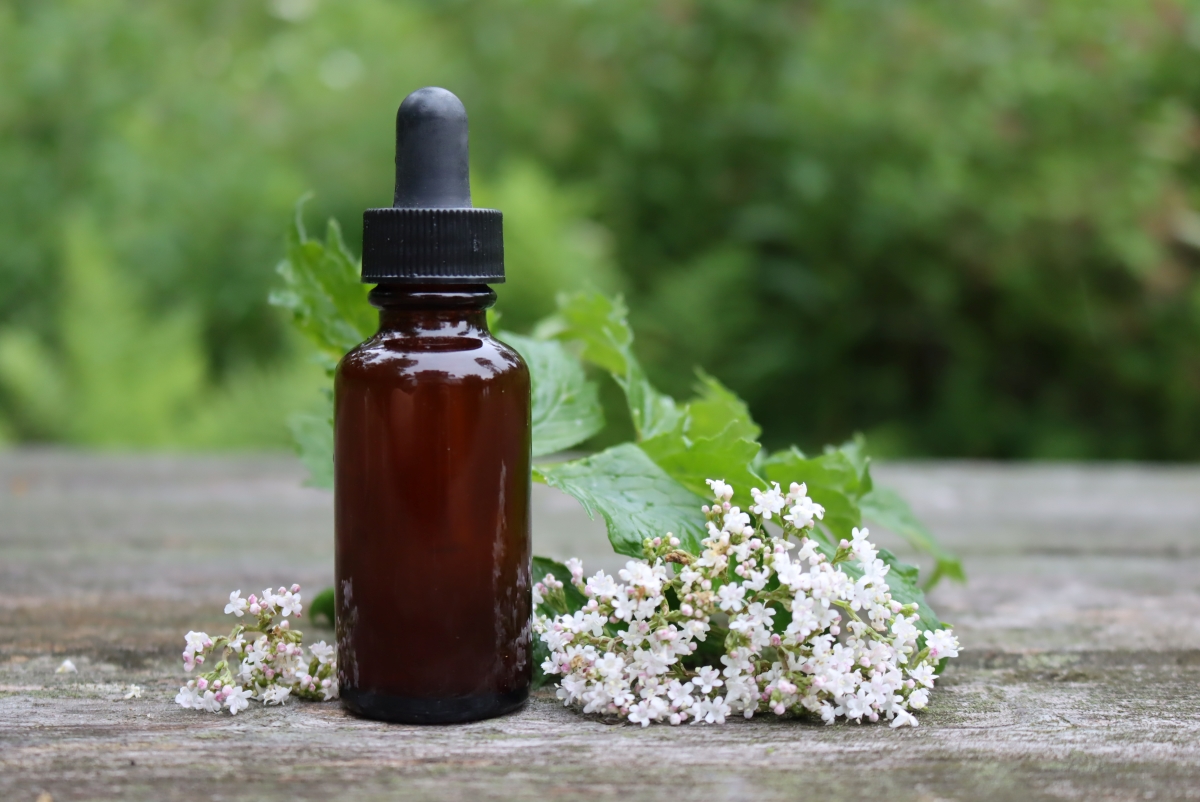
Valerian tincture was the very first tincture that I ever purchased, many years ago as a budding herbalist.
I was in my 20’s and on a semester abroad studying Italian when I came across it in the gift shop run by monks at Montecassino, just southeast of Rome. I wasn’t having trouble sleeping back in those carefree days, but I was excited to find a herbal souvenir in such an unlikely place.
Even then, I knew about the medicinal properties of valerian and thought it might come in handy if I really needed sleep on a stressful night before a test.
I never did use it. It’s amazing how easy sleep comes in college, and how well you can manage to function after an all-nighter when you’re young.
Fast forward 15 years and I’m the mama of two rambunctious little ones, and sleep is a lot harder to come by. Worries though, they’re easy enough to find.
I still had that quaint bottle of Valerian Tincture from the monastery, but 15 years well past the expected shelf life of herbal tinctures. They don’t exactly “spoil” but they do lose potency after about 2 years.
Seeing that bottle in the medicine cabinet was all the reminder I needed, and I started a batch of homemade valerian tincture that very afternoon with valerian roots harvested near the woods at the edge of my yard.
(I only home-harvested valerian root once. Since then I’ve purchased cleaned and dried valerian root because it’s incredibly hard to clean! Valerian also has deadly toxic look likes, so be careful harvesting it in the wild. You can grow you own valerian using Valerian Seed Packets, and it readily self-sows, so it’ll always be in your garden once planted.)
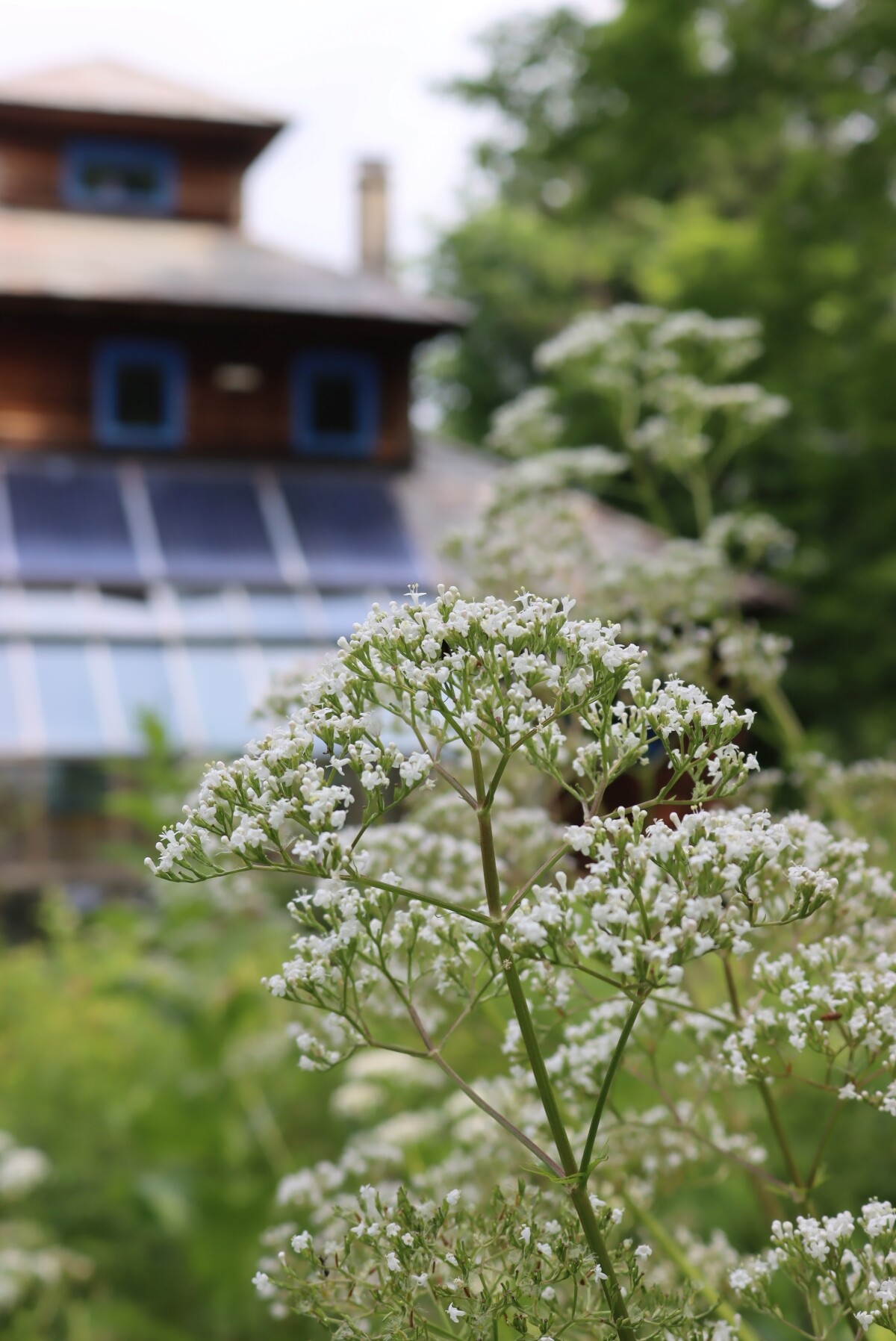
(Always consult your doctor or a clinical herbalist before trying any new herbal remedy, as there’s always the possibility of unintended consequences, allergic reaction, or interactions with other medication. If you’re harvesting wild plant material, make sure you’re 100% confident in your identification and consult multiple sources for your ID. The following is based on my research and experience, but I don’t claim to have any certifications that would qualify me to advise you on your health. Please do your own research and always verify with multiple reputable sources.)
Benefits of Valerian Tincture
Valerian has been used for its relaxing and sleep-inducing properties since at least the 18th century. It’s best known as a gentle sleep agent and nervine, helping to calm anxiety and insomnia in a non-habit-forming way.
At one time it was the herb of choice when treating women who had what was called the “vapors” (a rather vague diagnosis that described everything from fainting spells to hot flashes to mental illness).
While it may not be used to treat the vapors nowadays, the research we have on valerian root shows that it affects a neurotransmitter called GABA by preventing it from breaking down. In other words, it helps sustain and increase GABA levels in your brain, which is important because when GABA levels are low it can potentially lead to things like poor sleep quality and anxiety.
Valerian also has pretty amazing anti-spasticity properties, which means it works to prevent smooth muscle contraction of the uterus around the time you’re menstruating, resulting in much-welcomed pain relief during bouts of premenstrual cramping.
This double-blind clinical trial looked at the effects of valerian on the emotional, behavioral, and physical effects of premenstrual syndrome and found that individuals who were given valerian experienced a substantial decrease in the severity of all symptoms in comparison to the control group. The control group, of course, just suffered through their normal monthly discomfort.
One of the biggest appeals of valerian as herbal medicine is its lack of side effects compared to traditional medications which treat similar ailments. In addition to the research I’ve mentioned above, valerian extract is also being studied for its effect on:
- Obsessive-compulsive disorder
- Hyperactivity in children
- Hot flashes associated with menopause
- Restless leg syndrome
- Parkinson’s disease
In my case, I use valerian tincture on those nights when my mind won’t stop racing. A few droppers full and I drift off into peaceful sleep, waking up rested and ready to start my day.
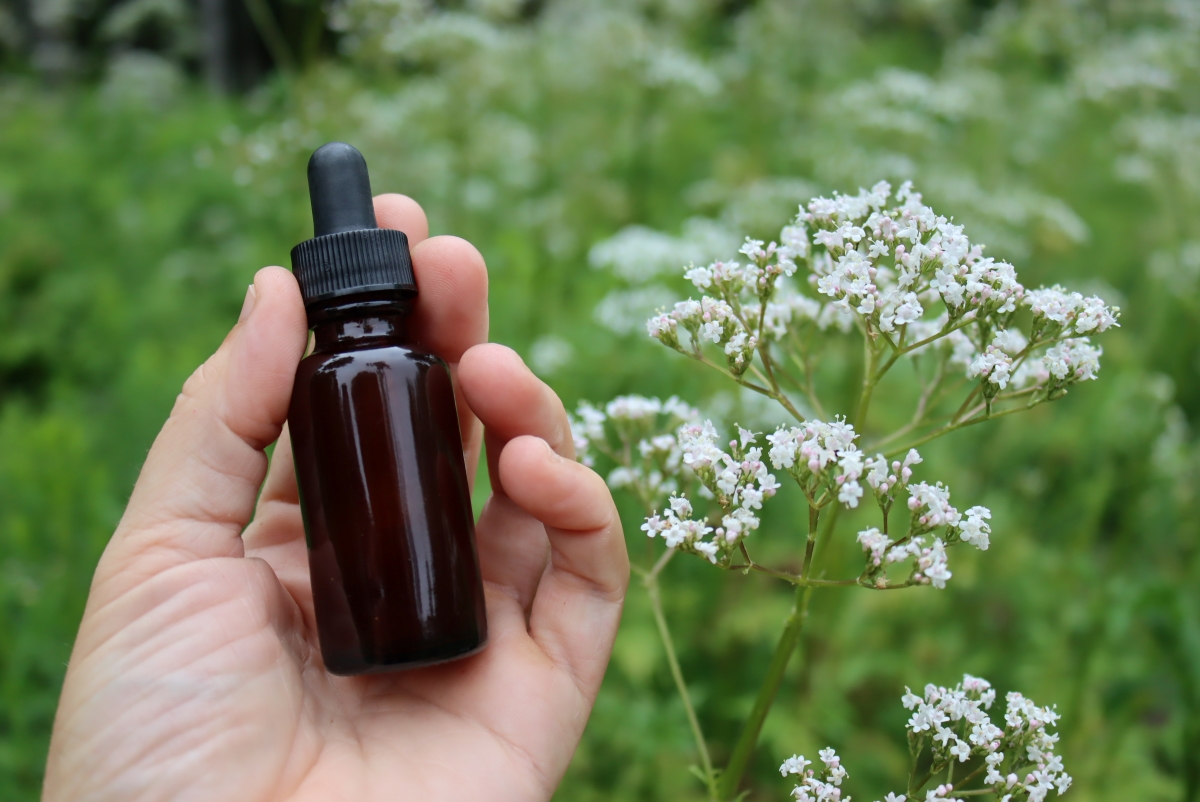
How to Make Valerian Tincture
To make a valerian tincture, you’ll need the following ingredients and equipment:
- 4 ounces dried valerian root (I recommend purchasing dried valerian root from either Mountain Rose Herbs or Starwest Botanicals)*
- Vodka (or any other palatable alcohol that’s at least 80 proof/40 percent — there’s no need to splurge here, I always use Smirnoff because it’s inexpensive and has a neutral taste)**
- One-pint mason jar with lid (amber glass is ideal, but as long as you keep the tincture away from light at all times it won’t make a difference)
- Funnel
- Cheesecloth
- Fine mesh sieve
- Amber glass tincture bottles (with dropper)
*If you feel up to the task of preparing fresh valerian root for this tincture, you are more than welcome to do so. I tried this method once and found that the fresh roots were so fine and difficult to clean that it wasn’t worth it — especially considering how inexpensive it is to buy dried (and much more manageable) valerian root. This post has more information about harvesting valerian, either homegrown or wild harvested. (You also don’t need to check for small pebbles mixed in with the roots, which is something that occurs infrequently anyway, because the dry matter is removed during the decanting stage.
**Never use isopropyl/rubbing alcohol for tinctures (or any other remedy you plan on ingesting). Even in small amounts, this type of alcohol is toxic and meant for external applications only.
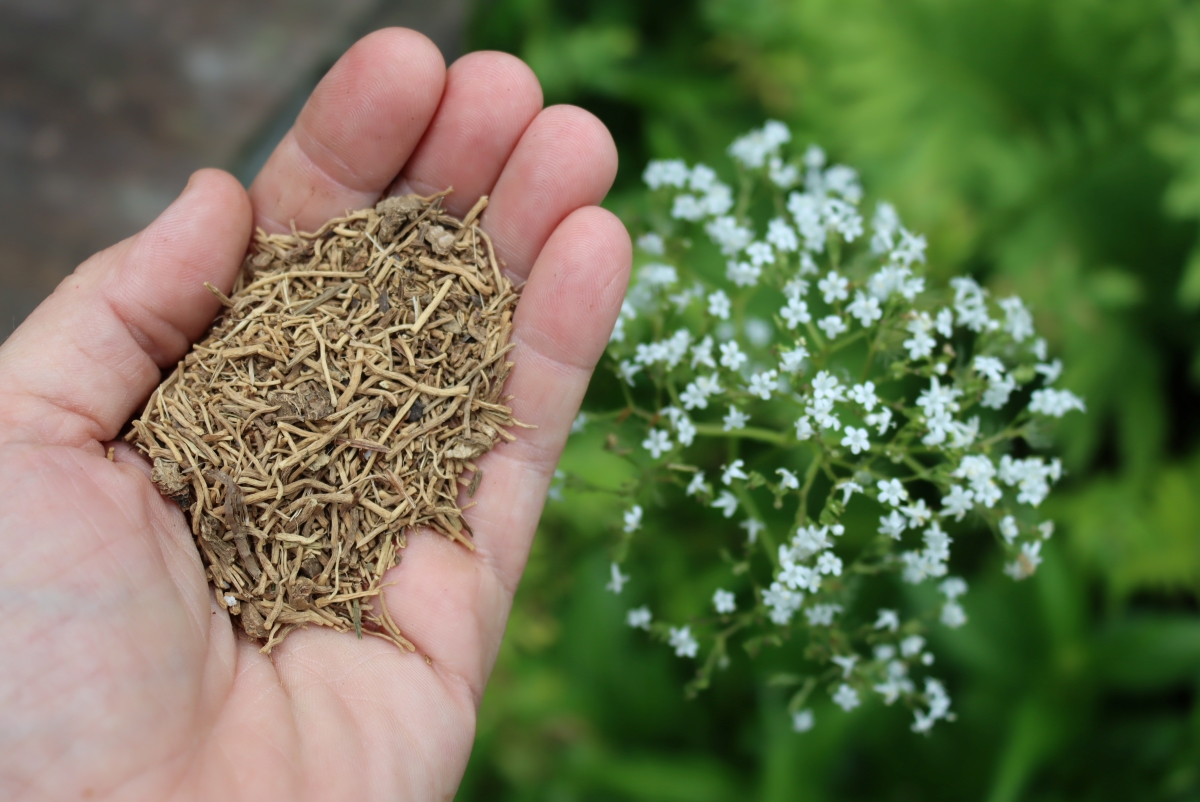
To make the tincture, add 4 ounces of dried valerian root to a clean one-pint jar.
Cover the valerian with vodka, or whichever alcohol you’ve chosen, and seal the jar with its lid.
Keep the developing tincture in a cool, dark place and give the jar a gentle shake every few days (daily is even better, but tinctures are, fortunately very forgiving when it comes to precise shaking schedules).
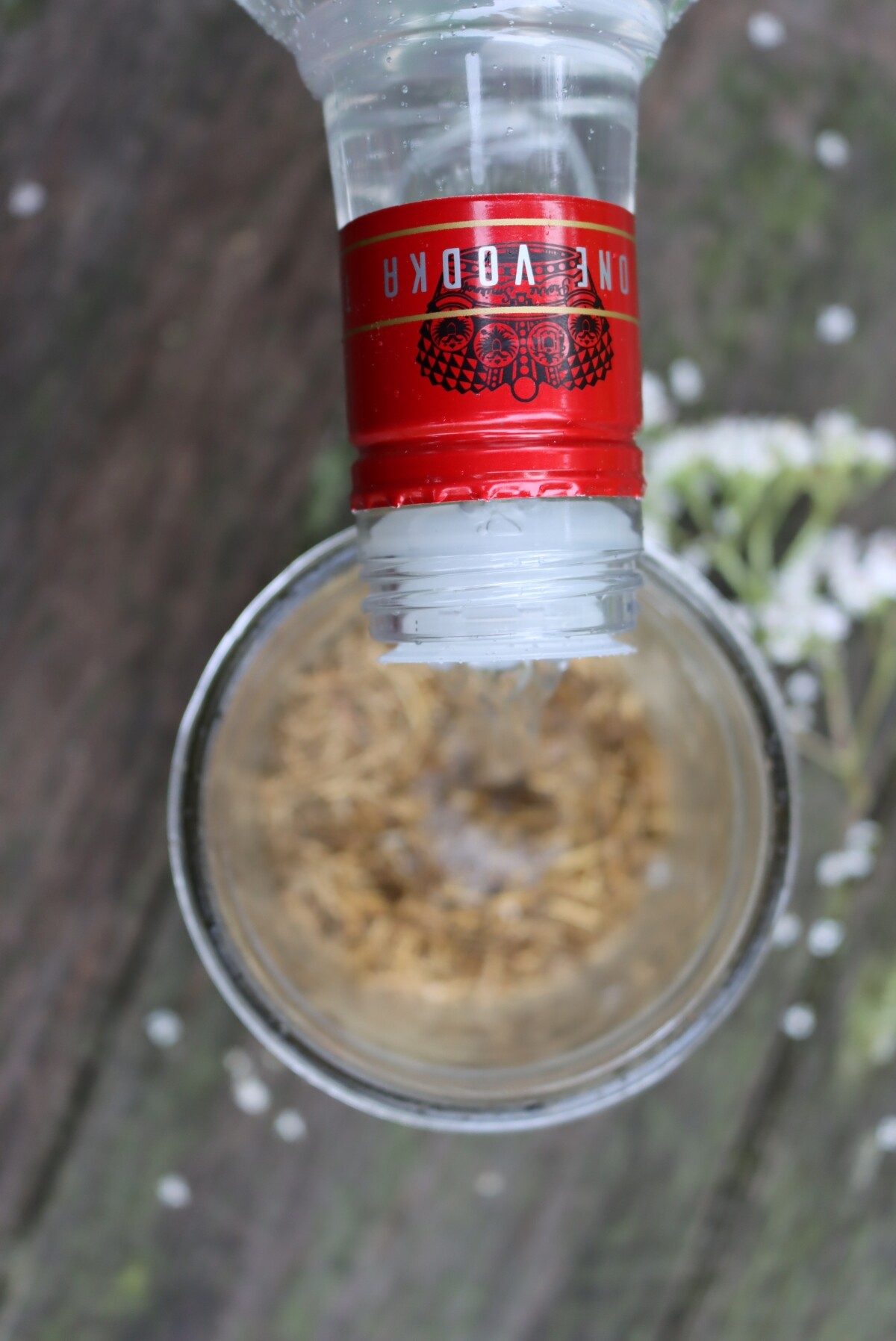
After about 4 to 6 weeks, it’s time to decant the tincture.
To do this, you’ll need to line a funnel with a few layers of cheesecloth (you can skip the cheesecloth if the pieces of valerian root are larger). Carefully strain the tincture into small amber glass tincture bottles, squeezing the roots to make sure all the liquid is expelled.
Once the tincture has been decanted, label the tincture bottles with the date and suggested dosages (I use a small piece of masking tape and a marker, it peels off easily when I’m ready to use the bottle for something else).
For more information on the general process, I’d suggest reading this guide to making herbal tinctures at home.
I know 4-6 weeks can be a long time to wait if you’re desperately needing restful sleep now. There’s nothing wrong with buying a bottle of valerian tincture to use while your homemade tincture infuses. Purchased tinctures are a lot more expensive than DIY homemade ones, but they have the benefit of being ready when you need them, like now.
Valerian Tincture Dosage
For an exact dosage specific to your body and needs, I’d suggest consulting a clinical herbalist.
Generally, the valerian tincture dosage used in study trials is often around 2 to 6 ml. That’s roughly 1 to 4 droppers full, as a tincture bottle dropper is about 1.5 ml.
For anxiety, it’s often taken 3 times a day over the course of several weeks. For insomnia, it’s usually just taken once about an hour before bedtime.
The effects are supposed to be cumulative, and most participants in the study didn’t see results until they had been using valerian tincture for 2 to 4 weeks. Personally, I’ve had good results after using it for just a few days, but everyone is different.
This is for healthy adults. Though it is sometimes used in hyperactive children, I haven’t found any specific guidance on either dosage or safety. I don’t suggest using it in children unless directed by a doctor or herbalist.
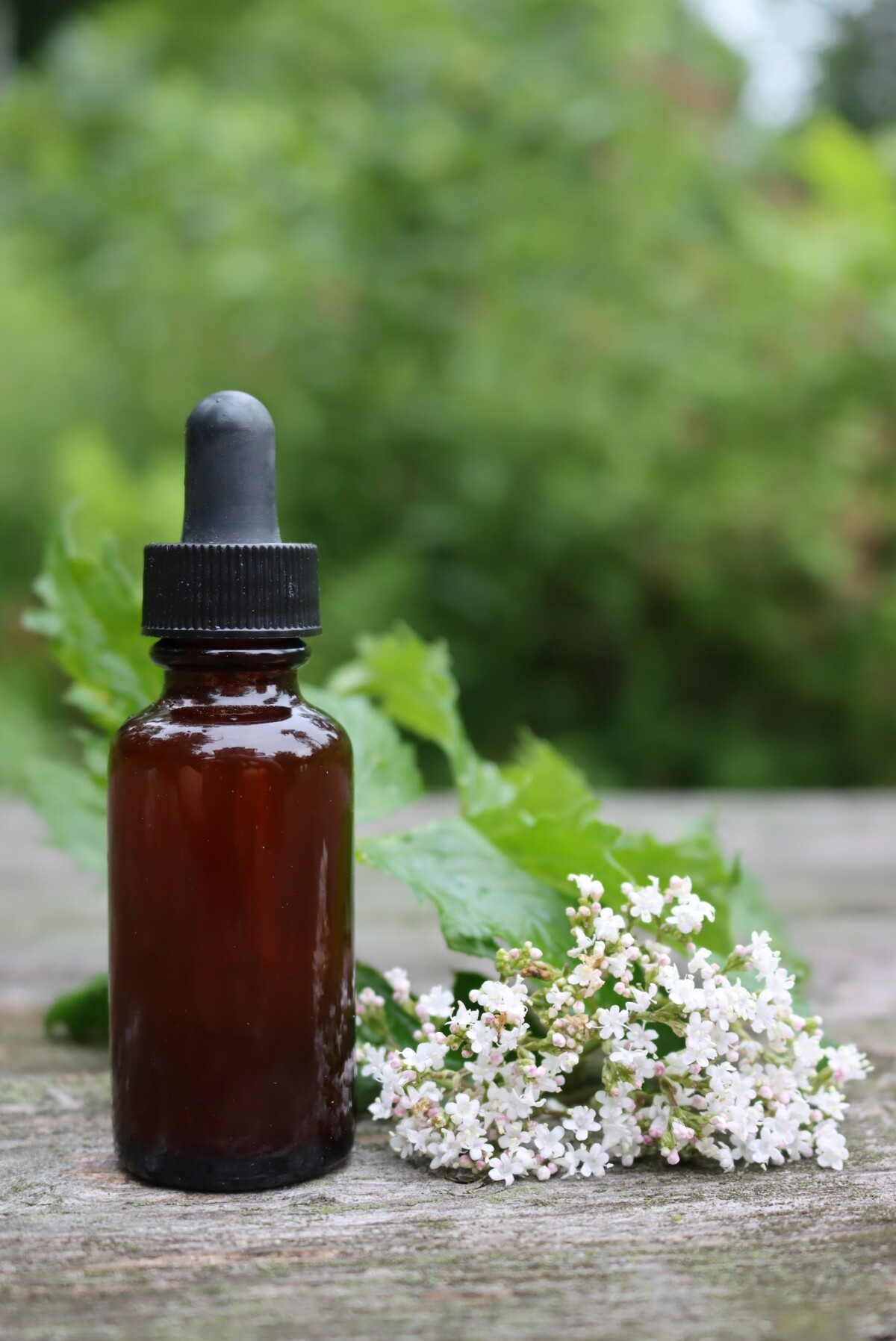
Valerian Formulations
If you’re struggling with sleep and feel like you need some extra backup, the combination of valerian and hops might be exactly what your body needs. Like valerian on its own, hops have been shown to increase GABA levels, but have the added bonus of lowering body temperature (which, when combined, can result in some much-needed deep sleep).
On its own, passionflower is used to alleviate anxiety (one of its more common uses is to relieve nervousness and instill a sense of calm before undergoing surgery). When taken with valerian, its soothing properties are even more pronounced.
Skullcap is another medicinal herb often combined with valerian that offers anxiety relief. Skullcap is also being studied for its potential role in treating symptoms of neurological disorders such as Parkinson’s disease and Alzheimer’s disease.
Valerian can be safely combined with chamomile, which can induce a state of relaxation while the valerian helps you to fall and stay asleep.
Other common herbal formulations include wild lettuce, which is both a pain reliever and a sleep aid, and blue vervain, which is useful for anxiety.
Mountain Rose Herbs has a sleep care tincture that includes valerian, wild lettuce, blue vervain, and hops.
Herb Pharm makes a Relaxing Sleep Tincture that includes valerian, passionflower, hops, and chamomile. That’s the one I’ve used when I find myself needing a valerian tincture before my homemade version is ready.
If you’re interested in the science behind combining herbs to enhance their effectiveness, I’d recommend taking this online course in Mastering Herbal Formulations from the Herbal Academy. It covers the science of blending herbs into homemade formulations in detail.
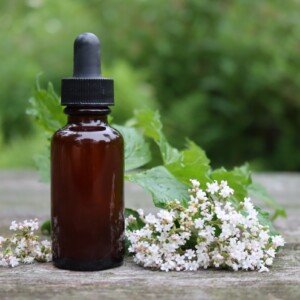
Valerian Tincture
Equipment
Ingredients
- 4 ounces dried valerian root
- Vodka or other palatable, neutral alcohol that is 80 proof/40 percent
Instructions
- Add dried valerian root to the mason jar.
- Fill the jar up with alcohol and seal with the lid. Give the jar a gentle shake.
- Store the developing tincture in a cool, dark place; shake the jar every couple of days (or every day, if you can remember).
- Let the tincture develop for 6 to 8 weeks.
- Decant the finished valerian extract by lining the funnel with cheesecloth and straining the liquid into the small tincture bottles.
- Label the tincture bottle with its contents, the date, and suggested dosages. Store in a cool, dark place.
Disclaimer on Homemade Herbal Remedies
I’ve been foraging wild medicines and treating my family with herbal remedies for the past 20 years, but I’m self-taught. Be aware that I am not a clinical herbalist, and this is based on my own research and personal experience using medicinal plants. I do not claim to have the experience that’d qualify me to advise you on your health, and I’m only providing this as a reference to encourage a broader interest in medicinal plants.
Please use this as a jumping-off point, but always do your own research and verify anything you read with multiple sources.
It’s always possible to have an adverse reaction to any medicinal herb, and plenty of people are allergic to even gentle herbs like chamomile. Always consult your doctor or a certified herbalist before trying any new medicinal plant. Often, they can have unintended reactions in combination with other herbs and supplements, and many herbs have side effects even when they are effective for their intended purpose.
If you are seriously interested in herbal medicine, I’d suggest investing in a course in herbal medicine, and I’d recommend any of the online courses put out by the Herbal Academy of New England. Specifically, the introduction to herbal medicine course and the family herbalist group of courses.
They also have a mushroom course, covering both medicinal and edible mushrooms, and a Botany and Wildcrafting Course. I’ve taken both and they’re informative, inspiring, and artfully presented.
Herbal Tinctures
Interested in making other homemade herbal tinctures?
- Yarrow Tincture
- Chickweed Tincture
- Elderberry Tincture
- Dandelion Tincture
- Burdock Tincture
- Echinacea Tincture
Herbal Medicine Making
Herbal medicines don’t stop at tinctures! Learn how to make more homemade medicine…
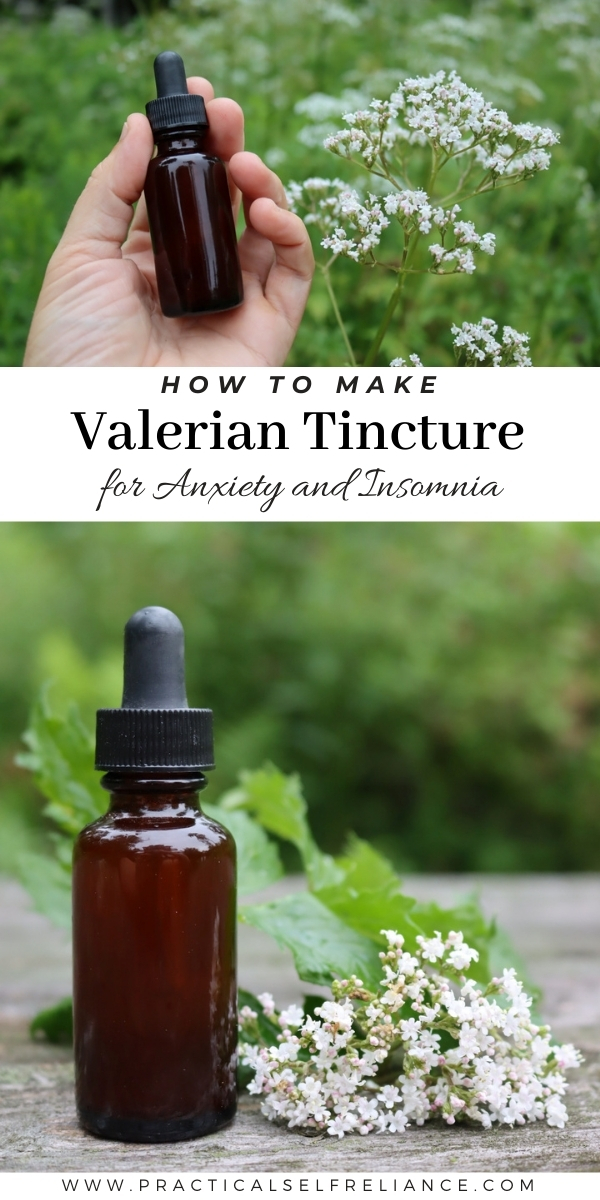
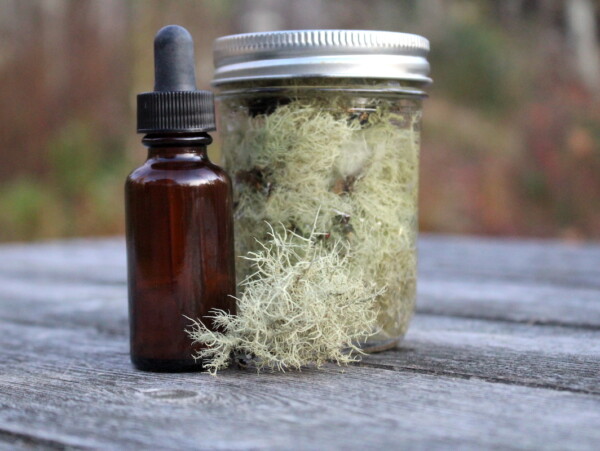
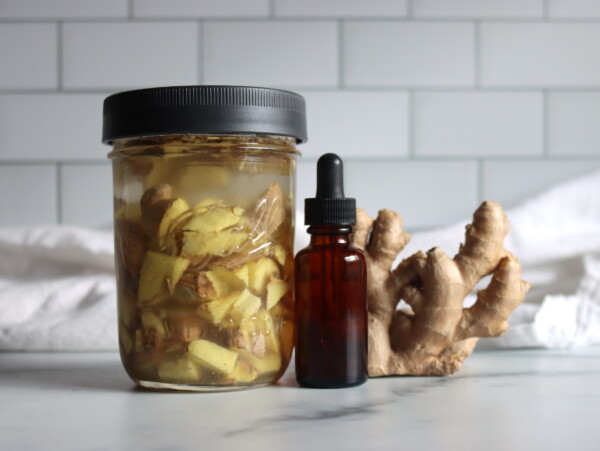
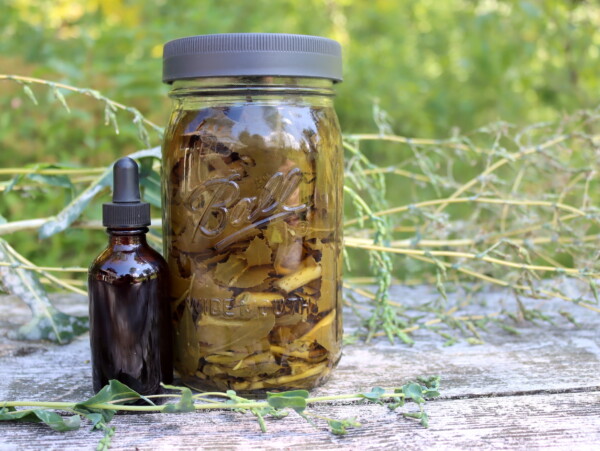
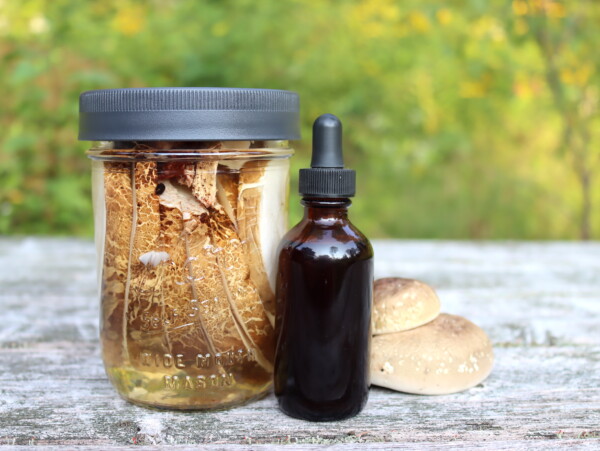










Hi Ashley, thanks for the recipe and the background! I’ve made a smaller amount of the tincture and I’m happy with the result, it’s made a clear improvement in sleep quality for me right away. Two questions I have are: 1) would 1 month infusion be sufficient to start using, while leaving the roots in to keep the tincture steeping? And 2) could you provide an estimate in grams of valerian to mL of spirit? Thank you!
After a month it’s already plenty strong, and yes, you can go ahead and start using it at that point. As to actual grams of valerian per ml of spirit, that’s a good question, and I’ve honestly never weighed it out. I always to it by volume in the jar. I’m due to make a new batch soon and I’ll weigh it out when I do. This is one of my favorite tinctures, I’m glad you’re loving it as much as I do! It makes such a difference for sleep!
Oh this makes sense now. I was trying to measure oz of valerian by weight, not by volume. So that seemed an enormous amount and I went for a smaller tincture, which was probably extremely saturated. Either way, wonderful tincture and best of luck with your next batch 🙂
Hello – I started your valerian root tincture recipe 4 days ago. After checking it frequently and topping off with more vodka (80;proof), I found there was almost no movement of the root when shaking the jar. So, I removed enough root material to fill a sterilized 8-ounce mason jar half way and added more vodka to both jars. I plan to strain off both jars and then combine the liquid. Do you think the final product will be too dilute to be effective?
Yes, I am new to making herbal medicine and want to produce a quality product for my family.
Your comments will be welcome. Thank you
The root does swell and absorb vodka while infusing. If the jar becomes too packed, just thin it out as you did, so that there’s still liquid circulating in there. No, it won’t be too dilute, you’re on the right track and did just the right thing. Best of luck with it!
I find that is helpful to keep each individual herbal tincture separate. You can combine them as needed. Because a pint iof tincture is quite a bit of tincture!
That’s a good point!
Thanks for this info. If I want to make a tincture from more that one plant, what proportions of each plant would I use? 1 oz of each?
It depends on the plant and the outcome that you’re wanting to have. I would recommend making individual tinctures and then you can experiment with the ratios but I would start off with an equal amount of each one and then you can adjust it as necessary.
Ma l’italiano, l’hai imparato oppure no? 😉
Esiste anche una ricetta di tintura madre fatta a casa senz’alcool?
You can make extractions with glycerine or vinegar if you don’t want to use alcohol but it won’t necessarily extract the constituents in the exact same way.
Hey there, thank you for this post. How much vodka do you use to the 4oz of valerian root please?
You just need enough vodka to fill up a pint-sized mason jar after you have added the herbs.
I’d be very careful about using the “cheapest vodka available” Much vodka is made with corn: and most likely GMO corn, as it is cheapest. But I also found this:
“most vodka today is produced from grains such as sorghum, corn, rye or wheat. Among grain vodkas, rye and wheat vodkas are generally considered superior. Some vodkas are made from potatoes, molasses, soybeans, grapes, rice, sugar beets and sometimes even byproducts of oil refining”
So, if you want GMO grains (cheaper) or even OIL REFINED BYPRODUCTS, (even cheaper?) go with the cheap stuff. Me, I prefer to use only organic alcohol for my concoctions. Yes, it IS more expensive and sometimes difficult to find, but what I put in my body is important to me. If you eat clean, why not use clean medicine? After all, isn’t that why we make our own?
Great post! I have made Valerian tincture from plants in my back yard. One way you can tell you’ve got the right plant is that the roots smell absolutely horrid (like dirty gym socks) You are right about cleaning them – very tedious and time consuming. I started out by plunging the whole root system in a bucket of water, then spraying it with high a pressure garden hose, then teasing the roots apart and washing them by hand in the kitchen sink. One plant will usually give you a whole lot of root to work with. It is a wonderful tincture to have on hand if you can get past the smell.
This is a great sleep aid.
Thanks for the information! I’m new to this and probably a stupid question but how does one apply this?
Tinctures like this one are usually taken orally. Just a few ml at a time usually, but the doses vary based on the type of tincture. Some tinctures are used topically (yarrow, black walnut, to name a few) but the overwhelming majority are just taken by mouth.